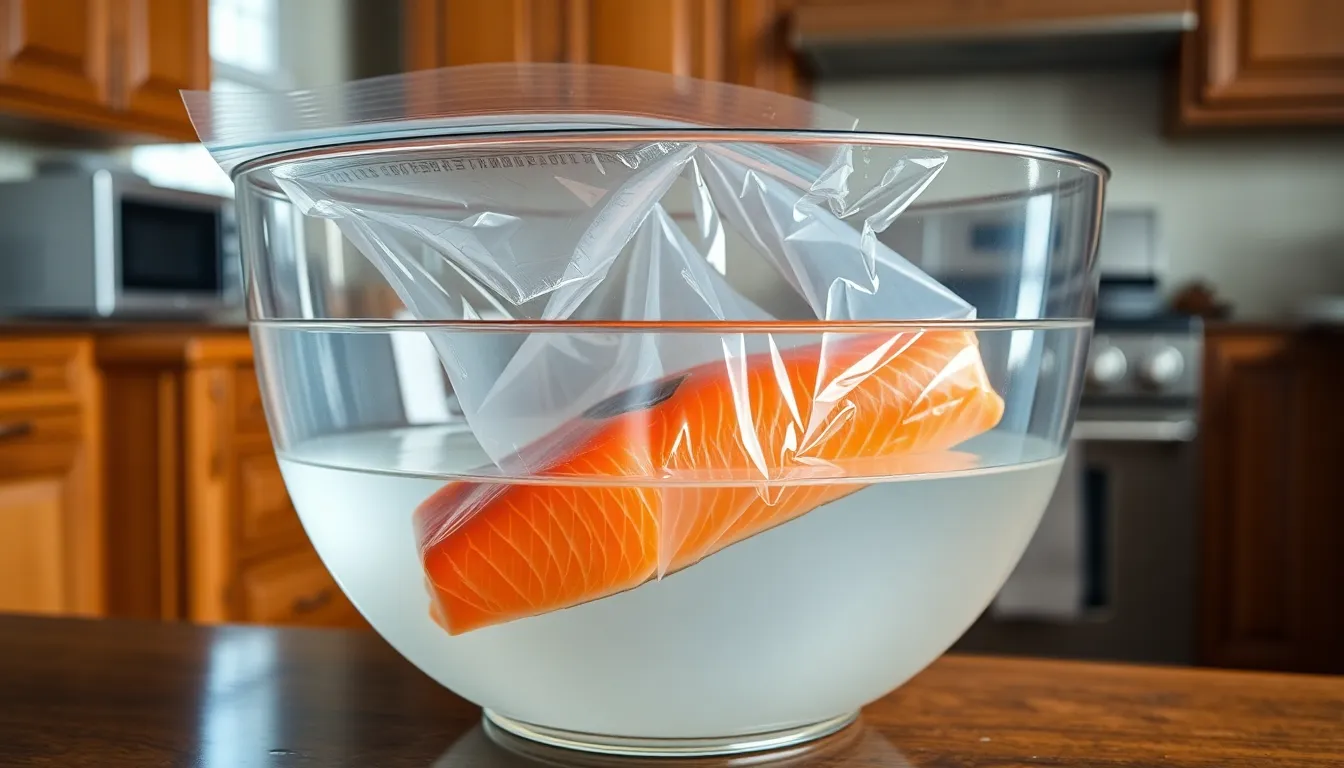Table of Contents
ToggleThawing salmon can be a hassle, especially when dinner plans come together at the last minute. With busy schedules and unexpected guests, knowing how to thaw salmon quickly can save the day. Whether it’s frozen fillets or a whole side, the right technique can ensure the fish remains fresh and flavorful.
In this guide, readers will discover effective methods to defrost salmon without compromising its quality. From quick water baths to microwave tips, these strategies will help anyone get their salmon ready for cooking in no time. Say goodbye to the long wait and hello to delicious meals that come together effortlessly.
Importance Of Thawing Salmon Properly
Thawing salmon properly enhances safety, texture, and flavor. It prevents the growth of harmful bacteria that can thrive in improperly thawed seafood. Effective thawing methods allow the salmon to retain its natural moisture and fats, ensuring a pleasant eating experience.
Improper thawing can lead to a rubbery texture. Quick methods, like cold water baths, minimize texture changes, making sure the fish stays tender. Additionally, even thawing promotes even cooking, reducing the risk of dry or unevenly cooked portions.
Flavor also stands out when thawing occurs correctly. Controlled thawing preserves the natural oils and tastes of salmon, maintaining its quality. Culinary experts recommend avoiding high-temperature methods, as they can alter taste and degrade the fish’s delicate flavors.
Understanding the importance of properly thawing salmon contributes to making nutritious, delicious meals. Adhering to effective thawing techniques not only secures food safety but also enhances the overall dining experience.
Methods To Thaw Salmon Quickly

Effective thawing methods help maintain the quality of salmon while preparing it for cooking. Two popular techniques include the cold water method and the microwave method.
Cold Water Method
The cold water method offers a quick and efficient way to thaw salmon. It involves the following steps:
- Seal the Salmon: Place the salmon in a leak-proof plastic bag to prevent water intrusion.
- Submerge in Cold Water: Fill a bowl or sink with cold water and submerge the sealed salmon. Replace the water every 30 minutes to ensure consistent cold temperatures.
- Check for Doneness: Thawing typically takes 30 to 60 minutes, depending on the thickness of the fillet or side. Make sure the salmon is pliable and no longer icy.
This method preserves the salmon’s texture and prevents the risk of bacterial growth associated with warmer water.
Microwave Method
The microwave method allows for rapid thawing but requires careful attention. Here’s how to do it effectively:
- Set the Microwave: Use the defrost setting on the microwave. Enter the weight of the salmon to calculate the appropriate thawing time.
- Position the Salmon: Place the salmon on a microwave-safe plate. Avoid using metal containers, as they can cause uneven thawing.
- Monitor Closely: Check the salmon every minute to ensure it defrosts evenly. Turn the fish to avoid cooking any sections. Remove the salmon as soon as it’s pliable but still cool.
With this method, use caution to prevent partially cooking the salmon during thawing, which can affect the final dish’s quality.
Tips For Thawing Salmon
Thawing salmon requires attention to detail to promote both safety and quality. Following effective techniques helps maintain the fish’s texture and flavor while avoiding potential pitfalls.
Avoiding Common Mistakes
- Using Warm Water: Avoid using warm or hot water to thaw salmon. This method can promote bacterial growth and negatively impact the fish’s texture.
- Leaving Salmon at Room Temperature: Never leave salmon to thaw at room temperature. This can lead to uneven thawing and the risk of foodborne illnesses.
- Not Checking for Ice Crystals: Check for ice crystals on the salmon. Any remaining ice indicates that it requires additional thawing time.
- Overcooking in Microwave: Monitor closely when thawing in the microwave. Overcooking can happen quickly, resulting in a rubbery texture rather than the desired moist fillet.
Ensuring Quality After Thawing
- Inspect Texture: Examine the salmon for a firm texture after thawing. If it feels mushy, it may have been thawed improperly and could affect the final dish.
- Rinse Before Cooking: Rinse the thawed salmon under cold water to remove any fishy odor. This step enhances the overall taste while ensuring freshness.
- Pat Dry: Pat the salmon dry with a paper towel before cooking. This promotes better browning and flavor during cooking.
- Cook Immediately: Cook thawed salmon immediately for optimal results. Delaying cooking can lead to a decline in quality, affecting taste and safety.
Thawing salmon quickly doesn’t have to be a daunting task. By utilizing the cold water or microwave methods, anyone can have perfectly thawed salmon ready for cooking in no time. Each technique offers its own advantages while ensuring the fish retains its flavor and texture.
Following the recommended thawing practices not only enhances the dining experience but also promotes food safety. Avoiding common pitfalls like using warm water or leaving salmon at room temperature is essential for maintaining quality. With these tips in mind, preparing a delicious salmon dish becomes a breeze, making mealtime enjoyable and stress-free.







